|
|
||
| Back |
Day 11 - McMurdo Station |
| This journal is constructed as one web page for each day of my journey, including the arrival day in Auckland, and the final two days, which I spent in Hobart. I have tried to keep the picture images of a reasonable size for easy web page loading. To see a much larger view of (practically) any image, just left-click on the photo. |
|
|
|
There was a ship in the "harbor" at McMurdo Station, the main
American base on the continent. So, the helicopters were used to
shuttle everyone to dry land. That worked out well, in that they
were used to pick us up from Scott Base, the New Zealand station, which
is only about a half mile from McMurdo. The flights were done
earlier than planned, and went fast. That was good news to me, as
my group was now at the end of the line (having been first to Cape
Evans). By 10:00 a.m., we were walking up the main road at
McMurdo.
My first impression of the station was that the roads must be a mess when it rains, because they are unpaved. Then, I remembered that Antarctica is really quite a dry place - they hardly get as much precipitation (and, that is snow) as does Phoenix! We used the local gym as our staging area, and were shown around the station by some volunteer guides. We started at an aquarium and then walked through the McCrary Science Building, which was reasonably new (1991). The buildings might get names, but they are otherwise referred to by their number in chronological order. Our guide thought that the oldest structure still standing was hut #10. Yes, and they are all referred to as "huts." We had the run of their local convenience store, before they opened for local folks. I picked up some tee shirts, post cards, and other Antarctic memorabilia. Then, we headed over to their local coffee shop to enjoy a mug of hot coffee, or tea (as is the preference for most of our passengers) and cookies. The two girls that work this shop were happy to chat with newcomers. They got their jobs through a job fair held in Denver, Colorado. Hmm... Of course, like most of the local population (about 1300), they are only here in the summer. They do work 6 day weeks and they don't really have any opportunities to get to visit other sites on the continent, which would interest me. |
|
|
|
We visited the National Science Foundation building -
really, it was the nicest looking place here. But, it was closed, so we
didn't get to see inside. I think there is an economics lesson here in
terms of how money gets spent. We also visited a chapel, all built with
donated material and volunteer time.
We did get to visit with a couple of people in different research offices. The guy that worked in the weather station had actually prepared a PowerPoint presentation for us! As I recall, he told us that there are only nine monitoring stations for the entire continent, which one can contrast to the many tens of thousands there are across the U.S. Then, it was back to the gym, pick up a box lunch, and head over to the Discovery hut, which was Scott's base of operations for his first trip to Antarctica, in 1902. Shackleton was a member of Scott's team on that journey, and he discovered the Beardmore Glacier, which afforded them a route up to the high polar plateau, where the South Pole is located. This expedition wasn't really organized to reach the South Pole, but it whetted many appetites in this regard. The hut is interesting in that it is quite unsuitable to the conditions. The party stayed aboard the Discovery all winter and only used the hut for storage. It also represents the furthest south anyone got with a hut in this area. When Shackleton returned in 1907, and Scott in 1911, this hut was many miles south of the open water. |
|
|
|
Of the four huts we have visited, this was the least
impressive. There was a hodgepodge of supplies strewn about. All
later explorers used this hut for storage, so it is really quite like looking
into someone's messy garage. Well, like mine! Still, as we duck into
the hut, we are transported back in time to the adventures of these men.
As you can tell from the photos, it is quite dwarfed by the McMurdo Station.
Between McMurdo Station and Scott Base, where we were to end our visit, is Observation Hill. Mike Usher had been especially keen to hike up this small peak, and made sure that there would be an opportunity to do so. I was glad to get a chance to walk around, after spending ten days aboard ship, and was anxious to join him in this climb. So, too, was David (my cabin-mate) and Marian, who was also in our landing group. So, after the hut, off we were to Observation Hill. The path to the top was steep, but it only took us about 20 minutes to climb. The views from up there were fantastic, and, as best I can tell from looking at a map, it was the furthest south that we got. That is, while it seemed like we were heading south to Scott Base, apparently we weren't. We were all quite enthused to be out and about for this little jaunt. |
|
|
||
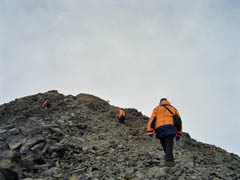 |
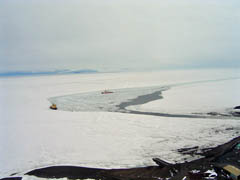 |
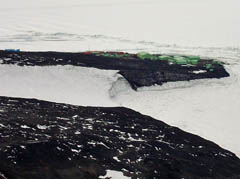 |
| Hiking up Observation Hill. | The KK and the Palmer clearing ice. | Scott Base from hilltop. |
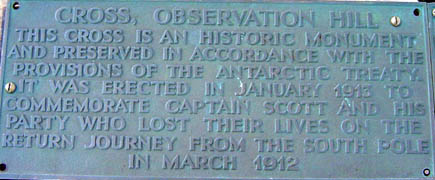 |
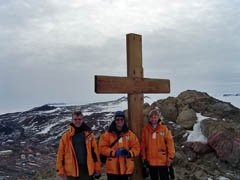 |
|
| Plaque marking the cross erected to commemorate Scott and his men. | Dennis, Mike & Marian at summit. | |
|
As we headed over to Scott Base, we could see the local
"airport." It is just a runway on the ice, about a half mile, or
so, from Scott Base. We did see a plane land, and it was quite
impressive. We knew that we were headed into a different world when we
passed by the welcome sign for Scott Base, with its icons for tenting, food,
boat ramps, phones, etc.
Unlike the American station, researchers that travel to Scott Base are usually not in residence very long. They collect data, but use facilities back in New Zealand to study and analyze what they have gathered. We visited the first hut here, which is now museum of sorts. It was built for Edmund Hillary's transantarctic expedition during the late 1950s. That was the trip Shackleton attempted in 1914, when his boat was trapped, and crushed, in the ice of the Weddell Sea. Hillary was the first to actually accomplish this feat, although his party did use mechanized vehicles for travel. |
|
|
||
| Welcome sign to McMurdo Station. |
A panorama of McMurdo Station from atop Observation Hill. |
|
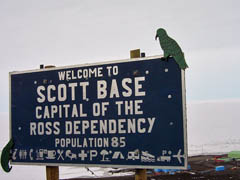
|
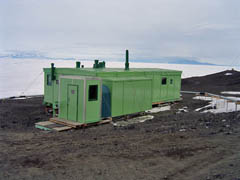 |
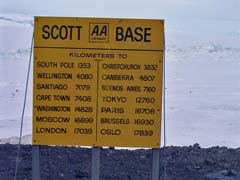 |
| Scott Base is ... a bit more casual! | Sir Edmund Hillary's hut (1950s). | How far is it to ... ? |
| Since we were at the end of the group all day, we weren't able to do much lounging around at Scott Base. They, also, had a little shop where I picked up a couple of items. Then, it was a helicopter ride back to the ship and our journey back. It was sad to be turning around, although we still had many fantastic places to visit. |
|
|
| Follow the "Next" and "Back" links to go from page to page. Or, return to the "Antarctica Home Page" and link to any day from the "Daily Logs" shown there. If you have any comments, e-mail me to me at: dfoster<at>kaibabjournal<dot>com. Please put “Antarctica” in the subject category. |